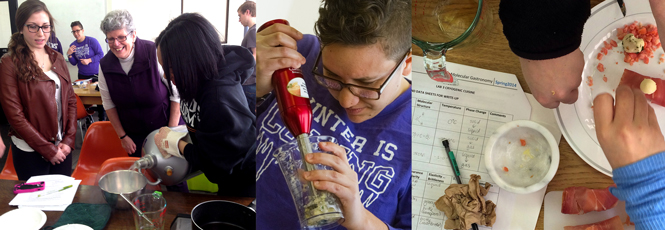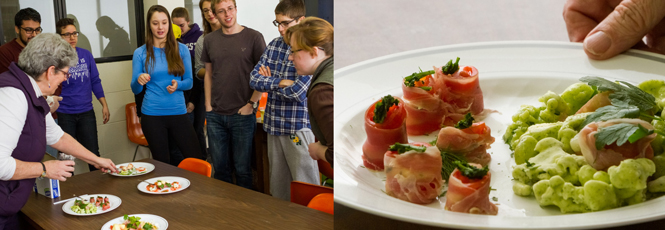By William Sweet
A tome on modernist cooking inspires chemistry students to treat liquid nitrogen as fondue.
[Courses] In Patricia O’Hara’s new introductory chemistry course, the periodic table of elements includes nitrogen, mozzarella and prosciutto.
“Molecular Gastronomy and Food Science: From Test Tubes to Taste Buds” seems like a cross between a cooking class and a science lab—and that’s the point, says O’Hara, the Amanda and Lisa Cross Professor of Chemistry: “I love science, and I really want my students to love it too, but so often they don’t see the relevance of the topics I’m teaching to their lives.”

Students in Patricia O’Hara’s new introductory chemistry course have done experiments both chemical and culinary, including dipping fruit, herbs, mozzarella and proscuitto in liquid nitrogen. “Students come to me,” O’Hara says, “with a passionate interest in learning more about food.”
She sought inspiration from a subject that gets practically everyone’s attention. “I felt there could not be a better vehicle than food. Essentially the act of eating, physically, is a combustion reaction,” says O’Hara, who leads workshops in Turkey on the science of olive oil and whose upcoming sabbatical will include a visit to South Africa to observe the spring olive harvest.
During the lab, she and her students cook and taste. For much of the semester they explored modernist cuisine, the science-based reconstruction of fine cooking advanced by physicist, inventor and amateur chef Nathan Myhrvold. Students read a chapter each week from Myhrvold’s Modernist Cuisine: The Art and Science of Cooking.

One winter morning they tried a high-tech version of an old New England favorite: “sugar on snow,” observing the qualities of hot maple syrup as it was poured on ordinary ice, dry ice (solid carbon dioxide) and liquid nitrogen. While the ordinary ice produced the sweet treat familiar to generations of northerners, the syrup descended into a congealed puddle beneath the dry ice. The liquid nitrogen put on a spectacular show of bubbling fog, leaving an amber-clear cluster of frozen sap crystals that melted in the mouth.
Reviews varied among students, several of whom had never tried maple syrup, let alone sugar on snow.
“I’m a fan of goo, so I like the dry ice,” said Elena Villafana ’14.
The cryocuisine lessons culminated in an Iron Chef-like cooking competition. Given ingredients including prosciutto, mozzarella, tomatoes and pineapple, lab partners were challenged to create an appetizer in 20 minutes.

They donned safety gloves and set to work grinding, slicing, arranging. In a new twist on fondue, they tried dipping ingredients in liquid nitrogen.
As students nibbled at their work, O’Hara polled each team about their next experiment: “Do you want seafood or steak?”
Photos by Rob Mattson